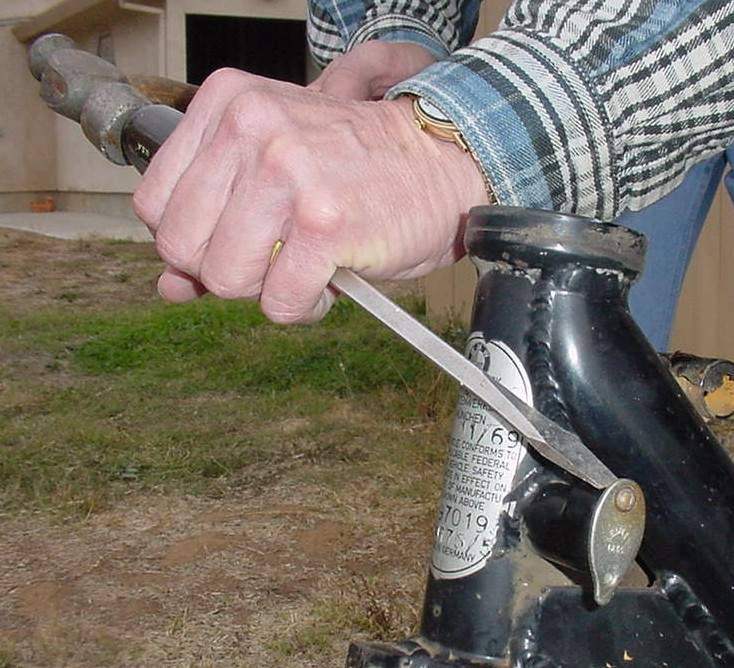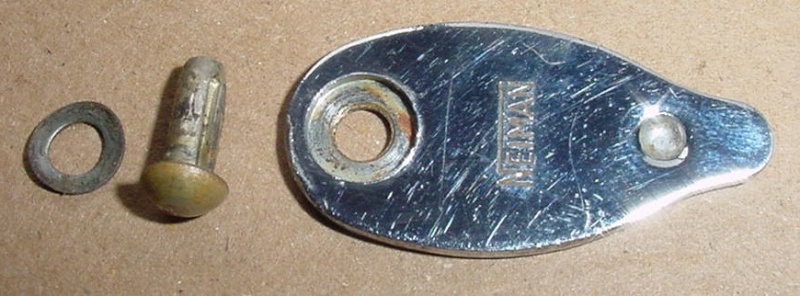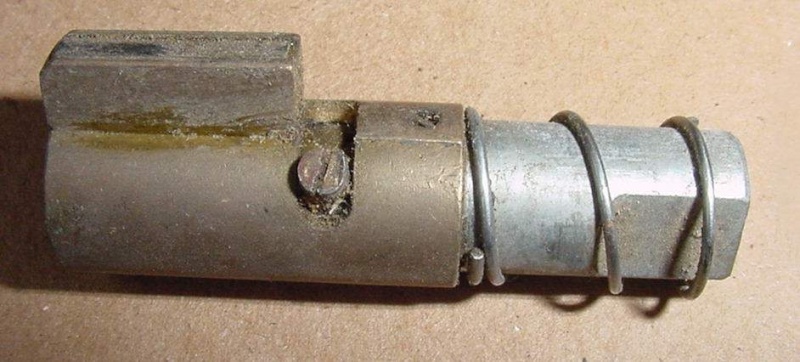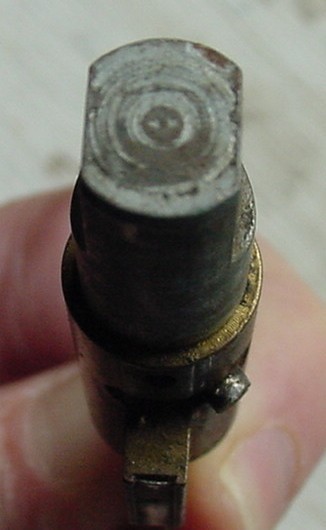Bloque guidon
4 participants
Page 1 sur 1
 Bloque guidon
Bloque guidon
Bonjour à tous,
Je cherche désespérément à démonter le bloque guidon de ma BMW R100RS et ne trouve rien sur le net pour m'y aider.
En effet, ma clé fonctionne, elle fait tourner la serrure mais je n'arrive pas à bloquer le guidon. je voudrais la démonter afin de voir d'où vient le problème.
Peut être l'un d'entre vous a t'il déjà eu ce problème ?
Quelqu'un pourrait il m'aider ?
Par avance merci.
Bullitt
Je cherche désespérément à démonter le bloque guidon de ma BMW R100RS et ne trouve rien sur le net pour m'y aider.
En effet, ma clé fonctionne, elle fait tourner la serrure mais je n'arrive pas à bloquer le guidon. je voudrais la démonter afin de voir d'où vient le problème.
Peut être l'un d'entre vous a t'il déjà eu ce problème ?
Quelqu'un pourrait il m'aider ?
Par avance merci.
Bullitt
bullittriders
 Re: Bloque guidon
Re: Bloque guidon
Ca arrive lorsqu'on dépose l'axe de colonne à la presse pour changer les roulements...et qu'on le remonte sans faire gaffe à la position du trou censé recevoir le penne de la serrure.
Ou aussi lorsqu'on donne un petit coup de guidon qui casse le supposé antivol... sachant ça, as-tu encore envie de t'emmerder?
Ou aussi lorsqu'on donne un petit coup de guidon qui casse le supposé antivol... sachant ça, as-tu encore envie de t'emmerder?

jbt
 Re: Bloque guidon
Re: Bloque guidon
Oui je voudrai vraiment réparer ce bloque guidon ou le changer... Histoire de pouvoir "sécuriser" un minima ma bécane lorsque je m'arrête faire une très rapide course et m'éviter de sortir les antivols !
Alors merci pour vos réponses...
Alors merci pour vos réponses...
bullittriders
 Re: Bloque guidon
Re: Bloque guidon
Pourquoi faire la perceuse ? Puisque j'ai la clé et qu'il tourne ???
Quelqu'un sait certainement comment demonter ce bloque guidon sans rien dégrader...
Quelqu'un sait certainement comment demonter ce bloque guidon sans rien dégrader...
bullittriders
 Re: Bloque guidon
Re: Bloque guidon
Pour les cylindres de blocage de direction bmw, je sait pas comment ils sortent.
J'ai un peu l'habitude des cylindres et il y'a toujours une manip a la con, genre tourner la clef jusqu'a une certaine position et le cylindre sort, une fois que tu a viré la ptite vis qui le tiens, ou fait sauter un rivert ou ..etc...
La j'imagine qu'il doit y avoir un blocage quelquonque, peut etre accessible qu'en sortant la colone de direction. Va jeter un oeil sur Realoem t'aura peut etre la reponse.
J'ai un peu l'habitude des cylindres et il y'a toujours une manip a la con, genre tourner la clef jusqu'a une certaine position et le cylindre sort, une fois que tu a viré la ptite vis qui le tiens, ou fait sauter un rivert ou ..etc...
La j'imagine qu'il doit y avoir un blocage quelquonque, peut etre accessible qu'en sortant la colone de direction. Va jeter un oeil sur Realoem t'aura peut etre la reponse.

flattwin66
 Re: Bloque guidon
Re: Bloque guidon
Si tu causes le perfide, tout est dit ici
Si tu le causes pas, je t'explique.
Si tu le causes pas, je t'explique.
____________________
Il n'est aucun problème qu'une absence de solution ne finisse par résoudre.

Flatosaure
 Re: Bloque guidon
Re: Bloque guidon
Bon, je te copie ce qui t'intéresse:
------
To do any procedure on the lock, the cover must be removed first. Here is how to do it. Having trouble getting at the backside of the lock cover? Just remove the 2 13mm, or 14mm bolts holding the headlight assembly and let it hang out of the way.
 1. Do you have the Neimann key? Remove the chrome lock cover shown above. Stick the key into the keyhole, turn it to the left till it stops, at about 10 O'clock, wiggle the forks a bit and pull the whole thing out. The spring should shove it out. Easy huh?
1. Do you have the Neimann key? Remove the chrome lock cover shown above. Stick the key into the keyhole, turn it to the left till it stops, at about 10 O'clock, wiggle the forks a bit and pull the whole thing out. The spring should shove it out. Easy huh?
3. No key and a bare frame. This sacrifices the lock, but you don't have a key anyway. Use a drift with a flat end and drive the lock into the frame about 3/8." That will shear off the screw holding the lock. Use a lever down in the steering stem hole and push the lock out.
4. No key and the bike is assembled. This is the most common case. One common suggestion is to "drill it out." Never stick a drill into the key hole and start drilling. You will hit the
tumblers made of hardened steel and the drill will break off. Now you do have a problem.
This is how to do it. This is so slick. It was first suggested to me in 1972, by Bryan Hilton, my genius mechanic. It would help to have the new lock in your possession so that you can examine it carefully to see what is otherwise "hidden" in the frame. The job is so easy though, that you probably can proceed by looking at these photos. Here are two pictures to show the lock.


In the first picture you can see the small screw in the middle of the lock. In the picture from above, you can see the screw sticking out from the round barrel at about 2 O'clock. The part at 12 O'clock is the assembly that holds the tumblers. The idea is to drill a hole into the lock and cut the head of the screw off from underneath. It sounds hard, but is actually quite easy.
Use a sharp center punch to make a dent in the lock at midway between 2 and 3 O'clock.
 I use a center punch to mark the place for the hole. I use a 1/8" drill bit. The main thing is to aim at the screw that you can't see. Most likely you will only partially cut the screw off. You can drill as far as 7/8" before you will go all of the way through the lock and hit the frame. Don't fret, you can gently tap on the lock and see if it will finish the job. If you can't finish breaking off the screw, then go up to the next size drill bit. You could force/screw a small bolt into the new hole and pull on it, but I have never had to do that.
I use a center punch to mark the place for the hole. I use a 1/8" drill bit. The main thing is to aim at the screw that you can't see. Most likely you will only partially cut the screw off. You can drill as far as 7/8" before you will go all of the way through the lock and hit the frame. Don't fret, you can gently tap on the lock and see if it will finish the job. If you can't finish breaking off the screw, then go up to the next size drill bit. You could force/screw a small bolt into the new hole and pull on it, but I have never had to do that.
With the lock out, carefully examine the hole in the frame and remove any metal shards. Carefully turn the forks while peering into the hole and see if the matching hole in the steering stem is narrow or widened out. That is evidence of someone trying to break the lock, as in a botched theft.
Upon reassembly, you will find that the "nail" that holds the chrome cover on the lock, will stay in. Just tap it in gently.
Rich Thrush said "the new lock mechanism that I ordered did not have the flats on the steel cylindrical portion." Apparently the new fork locks don't have the flats machined on the side. The shaft that protrudes into the steering stem is round. It won't fit into the slot in the stem. Here are some measurements to allow you to fix it. The slot in the steering stem is .402" wide and the distance across the flats is .292." We can say that an old lock has .100" of play. The owner of a new lock will need to grind off enough to go into the stem. I would not make it as small as the .292," but only enough to fit. The larger the "slop" the greater chance that someone will try to use that momentum to try to snap it off. The disadvantage is that the larger the lock is, the harder it is to "find" the hole when locking it up. See photos below.

 The steering lock, on the left, is an old one showing the flats. The steering stem, on the right, is a /5 stem with the slot milled into the stem. It is one of the luxury versions with the sides of the slot beveled off to assist in lock insertion. Many didn't have this minor feature. The /2 looks only slightly different. Before you install the chrome cover over your new lock, make sure the lock works. Some locks don't have the flats and the round barrel is too wide to go into the slot. Grind the flats to make it work.
The steering lock, on the left, is an old one showing the flats. The steering stem, on the right, is a /5 stem with the slot milled into the stem. It is one of the luxury versions with the sides of the slot beveled off to assist in lock insertion. Many didn't have this minor feature. The /2 looks only slightly different. Before you install the chrome cover over your new lock, make sure the lock works. Some locks don't have the flats and the round barrel is too wide to go into the slot. Grind the flats to make it work.
I received great suggestions from Reeve McGinniss and Rich Thrush, thanks.
------
BMW motorcycle fork steering lock removal and replacement
by Duane Ausherman
To do any procedure on the lock, the cover must be removed first. Here is how to do it. Having trouble getting at the backside of the lock cover? Just remove the 2 13mm, or 14mm bolts holding the headlight assembly and let it hang out of the way.

Remove the "boat shaped" chrome steering lock cover

These are the three pieces that will come flying off, so catch them.
The fork lock can be removed in four ways, depending upon conditions.
It will look like this.

2. You may be able to pick the lock yourself. Go to this website for the explanation by Charlie. Many won't be able to pick the lock. Here you can learn more than you ever wanted to know about lock picking. All else fails, take it to a locksmith.
3. No key and a bare frame. This sacrifices the lock, but you don't have a key anyway. Use a drift with a flat end and drive the lock into the frame about 3/8." That will shear off the screw holding the lock. Use a lever down in the steering stem hole and push the lock out.
4. No key and the bike is assembled. This is the most common case. One common suggestion is to "drill it out." Never stick a drill into the key hole and start drilling. You will hit the
tumblers made of hardened steel and the drill will break off. Now you do have a problem.
This is how to do it. This is so slick. It was first suggested to me in 1972, by Bryan Hilton, my genius mechanic. It would help to have the new lock in your possession so that you can examine it carefully to see what is otherwise "hidden" in the frame. The job is so easy though, that you probably can proceed by looking at these photos. Here are two pictures to show the lock.


Use a sharp center punch to make a dent in the lock at midway between 2 and 3 O'clock.

With the lock out, carefully examine the hole in the frame and remove any metal shards. Carefully turn the forks while peering into the hole and see if the matching hole in the steering stem is narrow or widened out. That is evidence of someone trying to break the lock, as in a botched theft.
Upon reassembly, you will find that the "nail" that holds the chrome cover on the lock, will stay in. Just tap it in gently.
Rich Thrush said "the new lock mechanism that I ordered did not have the flats on the steel cylindrical portion." Apparently the new fork locks don't have the flats machined on the side. The shaft that protrudes into the steering stem is round. It won't fit into the slot in the stem. Here are some measurements to allow you to fix it. The slot in the steering stem is .402" wide and the distance across the flats is .292." We can say that an old lock has .100" of play. The owner of a new lock will need to grind off enough to go into the stem. I would not make it as small as the .292," but only enough to fit. The larger the "slop" the greater chance that someone will try to use that momentum to try to snap it off. The disadvantage is that the larger the lock is, the harder it is to "find" the hole when locking it up. See photos below.


I received great suggestions from Reeve McGinniss and Rich Thrush, thanks.
____________________
Il n'est aucun problème qu'une absence de solution ne finisse par résoudre.

Flatosaure
 Re: Bloque guidon
Re: Bloque guidon
Nickel !!!
J'ai réussi à démonter tout ça sans rien casser et un petit coup de nettoyage et de regraissage et cela fonctionne.
Un grand merci à toi Flatosaure.
Bullitt.
J'ai réussi à démonter tout ça sans rien casser et un petit coup de nettoyage et de regraissage et cela fonctionne.
Un grand merci à toi Flatosaure.
Bullitt.
bullittriders
 Sujets similaires
Sujets similaires» kick bloqué
» [R100RT - 1995] changement du guidon d'origine par un guidon K1100LT - Résolu
» {80rt} passage d'un guidon haut à un guidon court quel cable d'embrayage et d'accélérateur ?
» Guidon ace bar (ou échange contre guidon de 100S)
» Axe roue arrière bloqué
» [R100RT - 1995] changement du guidon d'origine par un guidon K1100LT - Résolu
» {80rt} passage d'un guidon haut à un guidon court quel cable d'embrayage et d'accélérateur ?
» Guidon ace bar (ou échange contre guidon de 100S)
» Axe roue arrière bloqué
Page 1 sur 1
Permission de ce forum:
Vous ne pouvez pas répondre aux sujets dans ce forum
 Accueil
Accueil Portail
Portail RealOEM
RealOEM Flatis'Tech
Flatis'Tech S'enregistrer
S'enregistrer Connexion
Connexion
 bullittriders Lun 3 Nov 2014 - 12:58
bullittriders Lun 3 Nov 2014 - 12:58